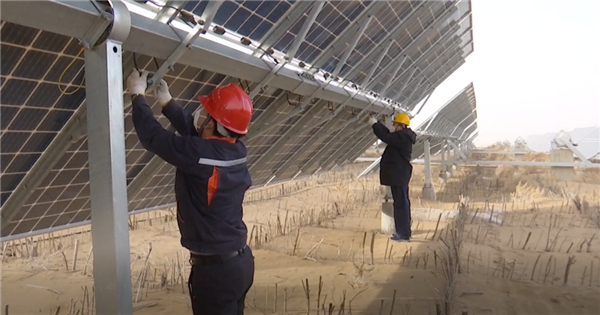Power to the people, courtesy of the sun

Workers maintain photovoltaic panels in April in Ordos, Inner Mongolia autonomous region. The city, a major coal production center in China, is optimizing its energy structure by introducing more clean energy. [Photo provided to chinadaily.com.cn]
Erratic access to stable electricity caused residents of drought-plagued Shilekai, a remote village in Ordos in the Inner Mongolia autonomous region, a lot of headaches.
Dependent on electric pumps to irrigate their farms, the low voltage of the power transmitted from the substation 25 kilometers away meant they were forced to use their pumps in shifts.
"It wasn't unusual that by the time it was my turn, it was already after midnight," Gao Daqi, an ethnic Hui villager recalled.
Now, the 58-year-old has bid farewell to these difficulties, thanks to a distributed photovoltaic power generation system he installed last year. Its solar panel also serves as the roof for his sheepfold.
He said previously, low voltage made the pump inefficient and irrigation costly but that now, thanks to the solar power system, his problems have been solved. Better yet, the panel shades his goats from the merciless sun.
Actually, the system brings Gao even greater benefits.
Covering an area of 200 square meters and costing about 90,000 yuan ($13,365), Gao's setup can generate 34,000 kilowatt-hours of electricity a year, so in addition to enjoying free power, he is able to sell the surplus back to the local grid for 0.28 yuan per kilowatt-hour.
Gao and his family have only recently emerged from poverty, so he paid 10,000 yuan for the system, with the remainder subsidized by local authorities.
He can make around 10,000 yuan a year from selling his surplus.
Chen Dongyao, chief technical engineer at Inner Mongolia Aohan Energy Technology, which developed the project, said that the system can work continuously for at least 25 years.
"The air here is very clean," he said. "This means high efficiency in power generation."
Chen said villagers don't need to do any maintenance as the company can debug the systems remotely. Using a mobile phone app, villagers can check how much power they have generated, as well as how much they have made from selling the surplus, he continued.
The company first had the idea to promote solar energy in the arid area in 2018, but large-scale development would have meant a lot of official procedures, which would have been time-consuming. Building sheepfolds using solar panels sidestepped that problem and was also able to address individual difficulties faster.
Chen said three households in the village already have systems installed, and another 64 families have signed up to buy. Those interested can apply for low-interest loans if they cannot afford the purchase outright.
The company plans to make Shilekai a pilot area for distributed photovoltaic power generation. "Based on the experience we gain from the village, we would like to extend the model to any area with poor access to stable power in Otog Banner and allow more farmers to benefit," he said.



 Print
Print Mail
Mail


